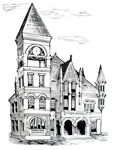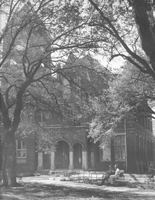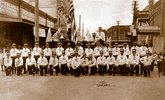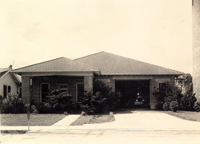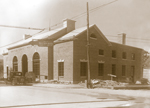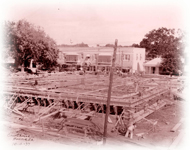- The first courthouse was erected at Bayou Cane, on land owned by Alex Dupre and H.S. Thibodaux.
- Houma's first jail was built by Pierre Cazeau. It was 12 square feet.
The History of Firefighting Technology in Houma
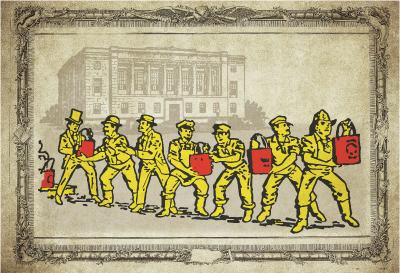
Before Houma’s first fire company was established, the city used the oldest known method of fighting fire: the bucket brigade. A line of volunteers would stretch from a water source (typically Bayou Terrebonne) to the scene of the fire. The volunteer closest to the water source would scoop up a bucket of water and pass it to the person next to him. That person would then pass it on to the person next to him and so on down the line until it reached the person closest to the fire. As each bucket arrived, the water would be thrown onto the flames, and the empty bucket would be passed back down the line. The brigade would pass multiple buckets down at a time in an effort to extinguish the flames.
Unfortunately, the bucket brigade method was a slow procedure. The most you could expect was to gain enough time to save some of your belongings. Most of the buildings that caught fire, all wooden back then, went up in flames.
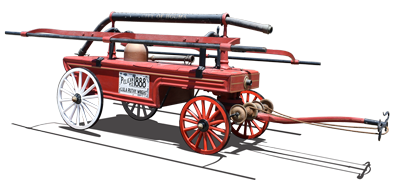
In 1888, Houma purchased a hand-pumper called the Lula Ruthy Wright to aid the firefighting volunteers. By this time, Houma’s Fire Company had been established, and the city’s first fire station had been constructed. The firemen would have to retrieve the hand-pumper and hoses from the fire station, then haul the equipment to the scene. When they arrived at the scene, they had to stand on each side of the pumper and pump the water onto the blaze by hand. Wells were dug every few blocks to access the water.

The steam engine was Houma’s next firefighting method. It is unknown which year this technology was implemented. The steam engine was an upright steam boiler which allowed the firemen to pump the water from the wells using steam.
A series of major downtown fires in the late 1800s lead to a revamping of building codes and the building of a pressurized water system to provide a reliable water source in the event of a fire. On September 9, 1902, a bid was awarded to build Houma’s first pressurized water system. 165,000 red bricks and 25,000 lake bricks were purchased to construct what many agree is one of Houma’s oldest and most recognizable landmarks: the tower at Wood and Roussel Streets. The tower stood at over 116 feet high, and the steel tank atop the structure held 40,000 gallons of water. The system was designed to use a steam engine to pump water from Bayou Terrebonne through cast-iron pipes to the tank atop the tower. Hydrants were scattered through then-downtown Houma, and homes and businesses could have water piped onto their premises by paying a monthly fee.

Houma's Fire Companies
The Houma Volunteer Fire Company No. 1 was organized on July 6, 1872. The company originated with 36 of the most influential men in the community. The members were constructive and active during the many years of its existence. On July 12, 1872, they secured a permit for the construction of what they called the “rooster fire station,” named for the white rooster weather vane atop the structure. The station was originally built along the bayou side. In 1896, the station was moved to Church Street to become the “rooster school.”
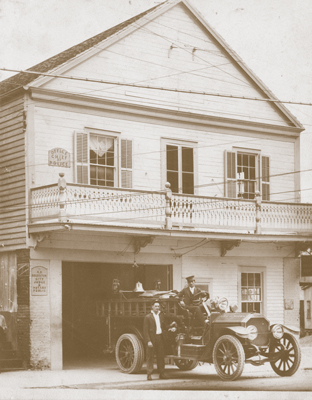
Houma’s second volunteer fire company, Houma Hook and Ladder Company No. 1, was incorporated on March 1, 1888, and was also comprised of prestigious men in the community. The company built a new hall on the northeast corner of Church and Verrett Streets. In addition to holding the fire apparatus and serving as a meeting place, the hall was also used as a place for social entertainments, holding court when the courthouse was being remodeled, and a public-school room. This building also housed Houma’s first fire bell.
On July 3, 1894, the Houma Volunteer Fire Company No. 1 obtained a grant to construct a new building which housed the new Hook and Ladder Hall. The building also housed an opera house, located in the rear of the structure. The belfry of this structure housed the second of Houma’s original fire bells. The bell was said to ring with a crisp, high “ding, ding, ding” sound, while the original in the old Hook and Ladder Hall tolled a low “dong, dong, dong” tone.
The original Hook and Ladder Hall was torn down in 1918. On January 6, 1920, the Houma Volunteer Fire Company No. 1 was reorganized. On June 25, 1930, a contract was executed to build a new fire station at the southeast corner of Roussel and Wood Streets. This station, known as the Central Station, remains aside the now-abandoned brick water tower. One of the original fire bells remains atop a structure at this station.
The market building at the northwest corner of Goode and Main Streets, originally built in 1857, was used as a fire station sometime before 1930 (exact years are unknown). This station housed the Effie Hellier, Houma’s first motorized firetruck.
Historical Timeline
- The city of Houma was founded.
- On May 5th, the original, one-story courthouse was built by Alex McMaster. It was constructed where the current courthouse stands today.
- The first post office was established August 1st.
One-story brick building was constructed by Thomas C. Nelson to house the office of the clerk, recorder, and sheriff.
Brick jail was constructed behind the courthouse. This jail was destroyed by Federal troops during the Civil War.
Construction began on the first public school in Terrebonne Parish.
Houma Volunteer Fire Company No. 1 was formed. The “rooster fire station” was built.
Following the Civil War, Felix Daspit resumed the construction of Houma's second courthouse.
A one-story jail was constructed by J.E. Naquin and H.R. Thiberge.

Houma Hook and Ladder Fire Company No. 1, Houma’s second fire company, began construction on the original Hook and Ladder Hall where the Courthouse Annex is now located. This was the original home of the deep-tolling bell and the hand pumper, the Lula Ruthy Wright.

- “Rooster Fire Station” was moved from the bayou side to Church Street to become a school. A new fire station, with an opera house and post office, is constructed on the vacated site. Postmaster Grinage moved in on October 30th.
- The new opera house hosted its first event October 28th featuring music by Professor A. Heicheheim's Orchestra. The first play, "Our Kittie," debuted on October 30th having been postponed due to bad weather.
Old kerosene street lamps disappeared with the arrival of electricity.
Wooden pedestrian bridge on Church Street gave way to Houma's first iron span.
The Hook and Ladder Hall was torn down to make way for Terrebonne High (later Houma Jr. High), which took over the entire block of Church and Verret Streets.
The opera house was demolished.
Houma’s first modern sewer system was installed.
Houma Elementary was constructed at the corner of Academy and Grinage Streets.
John Peter Beck's natural gas system installed in Houma.
Bayou Terrebonne declared non-navigable from New Orleans Boulevard to its source in Thibodaux. A couplet traffic system was instituted.
Present and Past Fire Chiefs
- Corey Henry 2021 - Present
- Keith Ward 2017 - 2021
- Todd Dufrene 2009 - 2017
- Daniel Scott 2006 - 2008
- Brian Hebert 2000 - 2006
- John Voisin 1998 - 2000
- Gale LeBoeuf 1987 - 1997
- Ernest Miller, Sr. 1980 - 1987
- Howard Oubre 1975 - 1980
- Bennie Bourg 1973 - 1974
- Homer Bland 1963 - 1970
- Leonce Doiron 1946 - 1963
- Hewitt LeBoeuf 1936 - 1946
- A.J. Bethancourt 1916 - 1936
